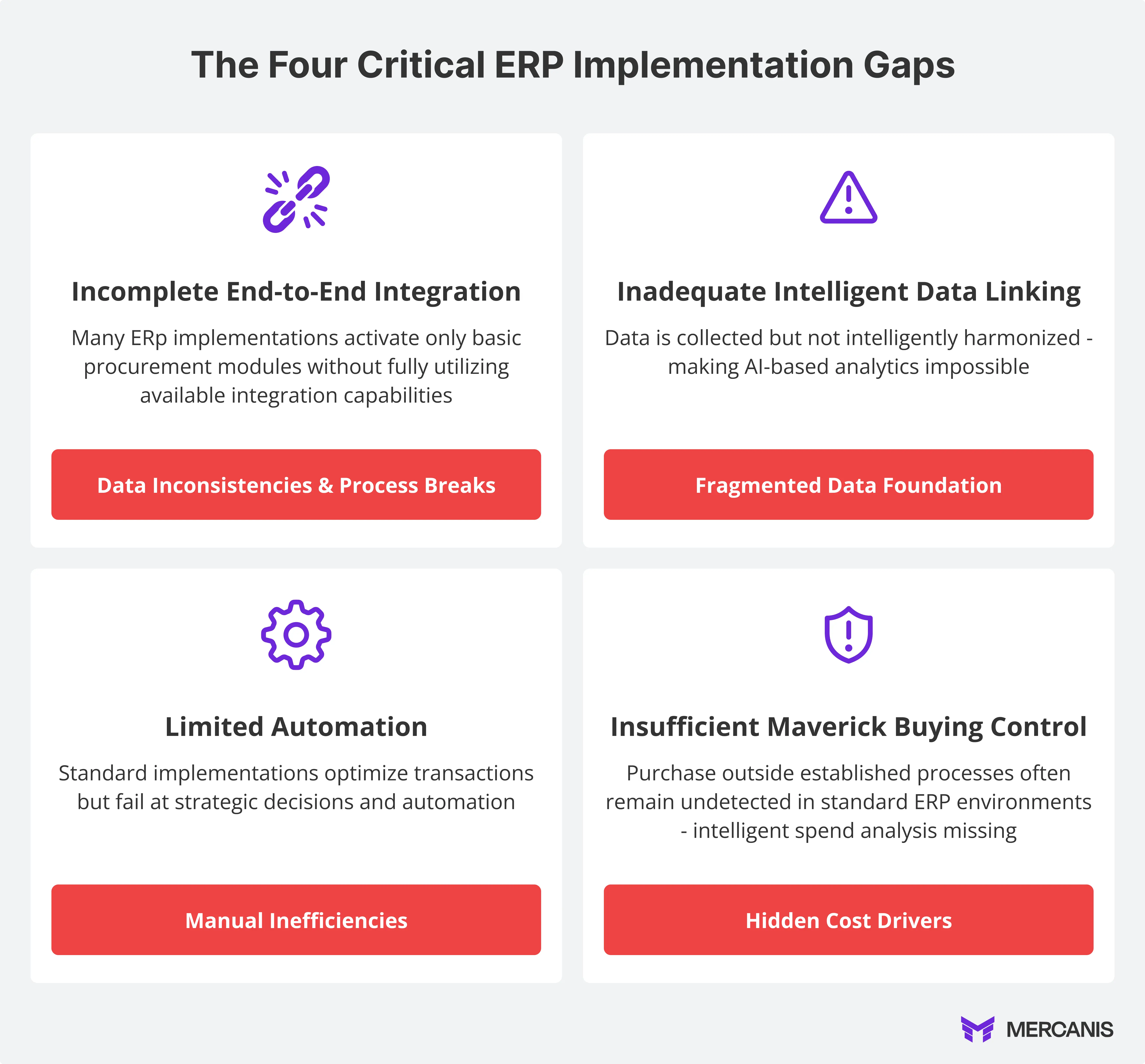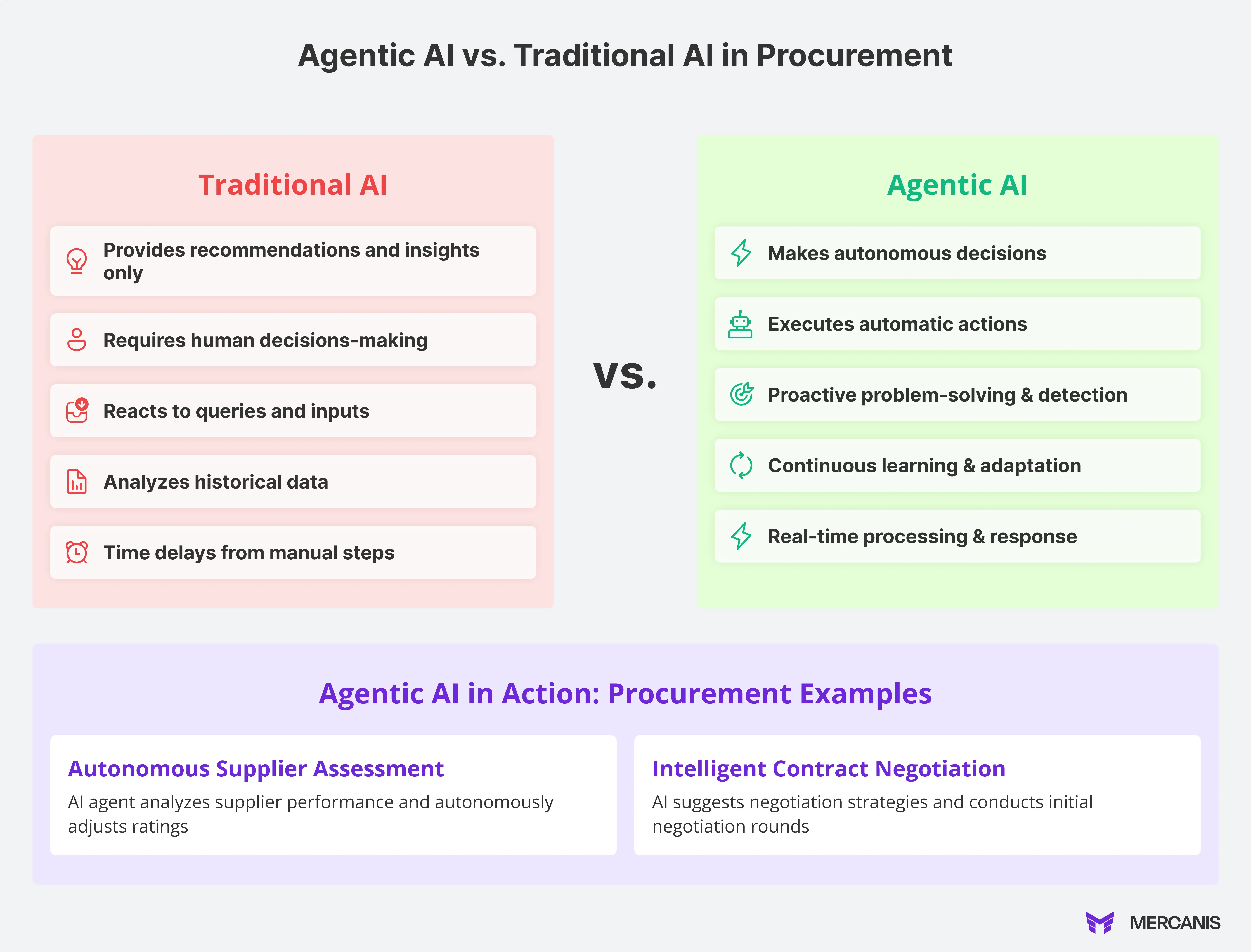
The moment had arrived: After 18 months of intensive implementation, millions in investments, and countless workshops, the new ERP system was live. Expectations were high. Finally, all business processes would run seamlessly, data silos would be a thing of the past, and digital transformation would become a reality.
But six months after going live, disillusionment is widespread. Despite investments in modern ERP systems, much of the procurement potential remains untapped, not because the systems are incapable, but because standard implementations often only activate basic functions. What was planned as a holistic solution is, in practice, a patchwork of basic modules that fails to take full advantage of the available integration options.
ERP systems form the indispensable backbone of enterprise IT. Modern ERP platforms offer advanced procurement functions, but in practice they often fail to deliver the end-to-end process integration that modern purchasing teams need for speed, resilience, and AI utilization. The problem lies not in the systems themselves, but in their practical implementation: time pressure, budget constraints, and complexity mean that many implementations remain stuck at the basic functions, while strategic modules remain unused. This gap between potential and reality is particularly painful in purchasing.
According to McKinsey's latest benchmark analysis, companies with world-class procurement maturity have EBITDA margins that are at least five percentage points higher than their less mature competitors. Many companies only use basic procurement modules of their ERP systems and do not take advantage of modern functions.
This is because traditional ERP implementations were primarily designed for transactional processes, not for strategic purchasing decisions. In its Procurement 2024 study, McKinsey identifies the need for procurement organizations to "adopt more sophisticated practices to meet both short-term challenges and the long-term vision for procurement in 2030."
1. Incomplete end-to-end integration in standard implementations
Many ERP implementations only activate basic procurement modules without fully exploiting the available integration options between demand determination, supplier selection, and contract management. This fragmentation leads to:
2. Lack of intelligent data linking
ERP systems collect data, but they do not harmonize it intelligently. As McKinsey notes in its study " Revolutionizing procurement ," "Procurement sits at the confluence of enormous amounts of data flowing both from within the organization and from outside it." But without intelligent harmonization, this data remains isolated and prevents AI-based analysis.
3. Limited automation of strategic decisions
While ERP systems optimize transactions, they fail when it comes to strategic decisions. In its analysis of the "Seven Forces Reshaping Procurement," BCG emphasizes that procurement executives must "continuously monitor various trends, assess their impact on supplier availability and costs, and use this information to support strategic decisions at the enterprise level."
4. Inadequate maverick buying control
The notorious "maverick buying," or purchases made outside of established processes, remains largely undetected in standard ERP environments. Without intelligent spend analysis capabilities, companies cannot identify when and where employees are bypassing established purchasing processes.

The impact of incomplete procurement integration goes far beyond traditional cost savings. McKinsey notes that "external spending plays a critical role in all performance dimensions, from cost and cash flow to carbon control and social impact."
1. Fragmented data blocks AI potential
Without harmonized data, AI models cannot reach their full potential. McKinsey emphasizes: "Mastering data will help procurement teams achieve strategic goals that go far beyond traditional cost, quality, and delivery metrics." However, fragmented ERP data prevents precisely this mastery.
2. High process costs due to media breaks
Every manual intervention costs time and money. McKinsey identifies the weaknesses of the traditional operating model as "a lack of reliable long-term planning, growing supplier concentration, limited insight into supplier economics, a lack of collaboration between functional teams, and a failure to adopt and scale proven technologies."
3. Flying blind when it comes to market intelligence
Standard ERP reporting provides historical data, but no forward-looking insights. At a time when "geopolitical tensions, rising inflation, climate disasters, and technological complexity have made today's business environment more volatile than ever," predictive analytics are essential for survival.
A Statista analysis shows that the global ERP software market is estimated to be worth US$913 billion in 2023, but the reality is sobering: many companies are only using a fraction of the potential of their ERP investments.
The true cost of ERP underutilization
While companies invest millions in ERP systems, new studies reveal alarming usage rates:
The ROI disillusionment: When millions in investments go up in smoke
The numbers speak for themselves: On average, companies saw a return on their ERP investment in just over 2.5 years. However, only 83% of companies that conducted a ROI analysis prior to implementation and had been live for more than a year said that the projects met their ROI expectations.
Even more alarming: 9% believe that their ERP has not delivered any ROI benefits for their company. With an average ERP investment of 2-4% of annual revenue, this means a misinvestment of $10-20 million for a company with $500 million in revenue.
The procurement paradox: high expectations, low reality
The discrepancy between investment and reality is particularly evident in procurement. Although 91% of companies report optimized inventory levels as the most common benefit after at least one year of live operation, most fail to make strategic use of their data.
71% of companies hope to use their ERP data to learn how to make their processes more efficient, but few manage to make the leap from hope to reality. The reason: standard ERP modules are optimized for transaction processing, not for strategic intelligence.
While some companies have implemented ERP procurement successfully, experience shows that the majority of standard implementations fail to realize their strategic potential – whether due to incomplete configuration, inadequate change management, or a lack of process reengineering measures.
While ERP systems form the indispensable foundation, specialized procurement suites complement the strategic level that is often missing in standard implementations. These systems are explicitly designed to pick up where standard ERP modules reach their practical limits and enable AI enablement.
The key difference: procurement suites harmonize and integrate all procurement data and processes. This is the only way to enable the meaningful use of AI, from predictive analytics and intelligent supplier matching to automated decisions.
1. End-to-end automation from RFP to contract
Modern suites create seamless workflows. Current developments show that "the latest cloud platforms merge GenAI drafting, reasoning modules, and workflow orchestration into a single interface."
2. Unified supplier data and risk profiles
Instead of fragmented supplier master data, suites offer a 360-degree view of each supplier. This enables intelligent risk assessments and data-driven selection decisions.
3. Process mapping as the basis for AI
The key lies in the intelligent mapping of all procurement processes. Deloitte's survey of over 100 CPOs shows that "the effectiveness of generative AI in procurement fundamentally depends on high-quality spend data, as actionable results depend on data quality."
4. Intelligent maverick buying prevention
Through continuous spend analysis and anomaly detection, modern suites identify maverick buying in real time and can initiate preventive measures.
Agentic AI systems, which can make decisions and execute actions independently, are revolutionizing procurement. While traditional AI only makes recommendations, Agentic AI systems can independently evaluate suppliers, pre-negotiate contracts, and perform compliance checks.

Deloitte's study impressively shows that "among those who have piloted or deployed artificial intelligence in procurement, about 50% saw a doubling of return on investment (ROI) compared to traditional methods, with some advanced implementations reporting ROI of more than 5x."
However, these impressive figures are only possible with integrated suites, not with isolated ERP modules.
AWG Mode: From manual compliance to digital excellence
AWG Mode, a leading German retailer with 240+ stores and over €200 million in annual revenue, faced a critical challenge: transforming its manual supplier management processes to meet LkSG compliance requirements.
The impressive result of the Mercanis implementation:
Chief Buying Officer Fabian Knoth confirms: "What impressed us most was how quickly we were able to achieve results. We reduced supplier onboarding from 6 weeks to 2 weeks."
Read the full AWG case study here.
Weinor: 38-41% time savings through intelligent automation
Awning manufacturer Weinor was looking for a solution to its tedious manual RFP/RFQ templates and Excel-based processes. The Mercanis implementation delivered impressive results.
Strategic Buyer Paul Rusk reports: "The Mercanis software saves my team about as much time (38-41%) as a full-time employee with 5 years of industry experience. What's more, procurement has become simple and can now be carried out by anyone."
Read the full Weinor case study here.
The statistics are sobering: 75-95% of all comprehensive digital transformation projects fail, mainly due to a lack of strategic clarity and insufficient process integration. The most common causes are a lack of vision, unclear goals, and attempts to modify complex ERP systems for specialized procurement requirements.
McKinsey's transformation analysis of 340,000 initiatives worth over $200 billion reveals some shocking truths: Large IT projects exceed their budgets by 45% and their schedules by 7%, while delivering 56% less value than predicted.
Even more dramatic: 88% of business transformations fail to achieve their original ambitions, and 75% of all ERP projects fail.
The difference lies in the approach. While ERP transformations attempt to solve everything at once, successful suite integrations rely on:
1. Step-by-step integration As AWG Mode shows: First 80% of core functionality in 2 weeks, then continuous expansion.
2. User focus Weinor's experience confirms: The suite makes "procurement easy and can now be carried out by anyone."
3. Data-centric approach McKinsey emphasizes: Companies that have successfully scaled an analytics transformation focus on a prioritized set of five or six technical solutions selected based on their value potential.
AI only becomes valuable when data and processes are integrated. ROI does not come from AI alone, but from the platform that feeds it. Studies show that "AI investments now deliver an average return of 3.5X, with 5% of companies reporting returns of up to 8X."
Companies that integrate procurement suites have been shown to achieve:
Process speed: Up to 50% faster turnaround times through automated workflows
Cost savings: 20% higher savings through AI-optimized negotiation strategies
Compliance improvement: Roland Berger predicts that "AI could improve compliance by up to 100% by 2025."
1. Operational efficiency
GEP Analytics shows that "automating invoice processing can lead to significant savings for the thousands of invoices that companies process every month." Modern suites automate up to 80% of routine tasks.
2. Strategic insights
Through "advanced AI analytics, teams can perform market basket analysis to understand which suppliers frequently bid together and then optimize the bidding mix."
3. Risk minimization
Integrated suites enable real-time risk assessments and proactive measures before problems arise.
The numbers are alarming: Only 14% of procurement executives agree that they have enough talent to meet future procurement function requirements.
Amazon Business's 2024 State of Procurement Report identifies the top two priorities for the next two years:
As traditional ERP skills become commoditized, new skill requirements are emerging:
McKinsey notes that smaller organizations are using intelligent procurement strategies and new technologies to keep pace with larger organizations and, in some cases, outperform them. The reason: suite-based tools are democratizing advanced analytics.
Germany is facing a unique opportunity. While global players dominate, specialized providers such as Mercanis offer exactly the hybrid-intelligent solution that German SMEs and corporations need.
The advantage of German suite providers lies in deep localization: As an agentic AI platform, Mercanis goes beyond traditional automation: AI agents can independently perform supplier evaluations, identify compliance risks, and even suggest negotiation strategies, all with the regulatory depth required for the German market. Cloud-based platforms that combine procurement, supplier management, and contract management in a single solution offer a decisive speed advantage during implementation.
The AWG Mode and Weinor case studies show that German companies that rely on Mercanis achieve above-average implementation speeds and ROI values – proof that the combination of German thoroughness and agile technological innovation is a winning formula.
German SMEs in particular benefit from providers who understand both the regulatory complexities and the operational realities of SME structures. While global enterprise solutions are often oversized and cumbersome, German companies need agile platforms that can be implemented quickly and create immediate value. Experience shows that companies that rely on German suite expertise such as Mercanis significantly reduce their time-to-value and achieve sustainable ROI without having to take the typical risks of lengthy ERP transformations.
As the CPO of a chemical company told McKinsey: "Today, companies need a different end-to-end view of the business to perform well. Procurement is absolutely critical."
However, this end-to-end view cannot be achieved with standard ERP modules. The future belongs to hybrid approaches that combine ERP stability with suite intelligence.
Gartner's analysis shows: "GenAI can already improve many different workflows in procurement, and 73% of procurement executives expected to adopt the technology by the end of 2024."
The message is clear: ERP remains the indispensable backbone for transaction stability, while specialized suites form the intelligent brain for strategic procurement intelligence and AI integration.
The success stories of AWG Mode and Weinor show that German companies that act now and supplement their ERP systems with intelligent procurement suites are securing a decisive competitive advantage.
The future of procurement lies in intelligent interaction: ERP for operational excellence, procurement suites for strategic intelligence. The question is not either/or, but how quickly you can leverage this synergy for your business.

Agentic AI makes independent decisions and performs automatic actions, while traditional AI only makes recommendations. Agentic AI systems can independently evaluate suppliers, pre-negotiate contracts, and perform compliance checks—without human intervention at every step.

Modern procurement suites can be implemented in 2-8 weeks, compared to 18+ months for ERP transformations. For example, AWG Mode achieved a 2-week go-live with 80% of core functionality available immediately, followed by continuous expansion.

Modern cloud-based suites are designed for easy integration. APIs and standard connectors enable seamless connection to existing systems. The focus is on plug-and-play functionality rather than complex system integration.

Most suites can start with basic data from your ERP: supplier master data, spend data from the last 12-24 months, and current contracts. Modern AI systems can learn from limited data sets and continuously improve. No "big bang" with perfect data is necessary start lean and scale is the recipe for success.





